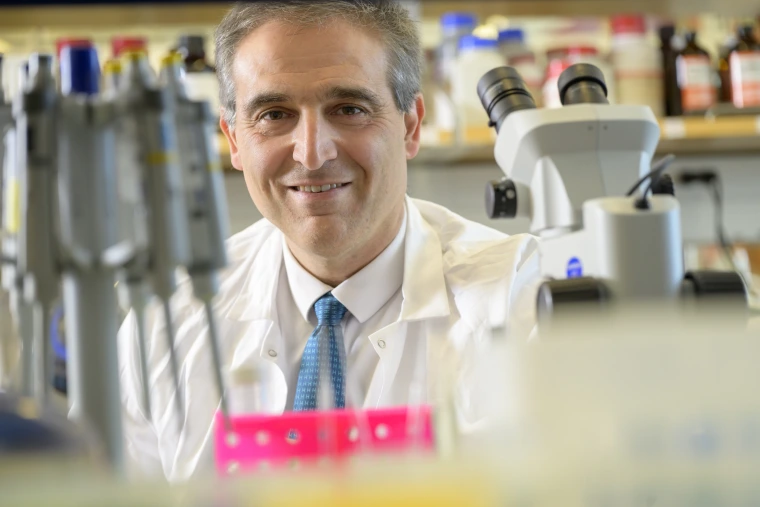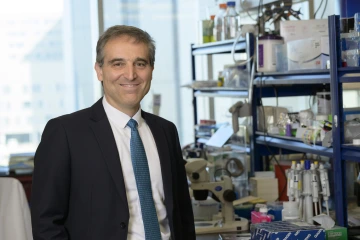Turning back the clock on heart failure: Drug candidate may expand options for difficult-to-treat heart disease
A research team helmed by Sarver Heart Center Associate Director Hossein Ardehali, MD, PhD, illuminates a potential path toward reversing a type of heart disease that lacks good treatments.

Kris Hanning, UAHS Office of Communications
A study led by a physician-scientist at the University of Arizona College of Medicine – Tucson’s Sarver Heart Center identified a drug candidate that appears to reverse the progression of a type of heart failure in mouse models, which they hope will lead to expanded treatment options for humans. The results were published in the journal Cell Metabolism.
Heart failure occurs when the heart doesn’t pump blood properly. In about half of cases, the muscle is weak and has difficulty pumping. The rest result from a stiff muscle, a type called heart failure with preserved ejection fraction, or HFpEF.
“When we are young, the heart relaxes and blood goes into it,” said senior author Hossein Ardehali, MD, PhD, associate director of the Sarver Heart Center, associate dean for translational research, director of the Translational Research Program and Irving J. Levinson Professor of Cardiology. “As we get older, the heart becomes stiff. It’s not elastic anymore, so blood doesn’t go into the heart easily. That can cause heart failure — one of the most common causes of death and hospitalization in this country.”
The path to heart disease
To learn more about what causes HFpEF, Dr. Ardehali’s team, which includes researchers from Northwestern University, University of California at San Diego and the University of Pennsylvania, peered inside endothelial cells, which line the blood vessels. By developing the first animal model of spontaneous HFpEF, they could follow these cells on their journey from healthy to dysfunctional and identify what activates the disease state.

Kris Hanning, UAHS Office of Communications
They found that one key ingredient in triggering HFpEF is an enzyme that escapes into an area of the cell where it’s not normally found. Once there, it reacts with another enzyme to convert glucose, a type of sugar, into harmful byproducts that set off a chain reaction, ultimately reducing the heart’s elasticity.
“Nobody had shown this before,” Dr. Ardehali said. “It makes sense, because HFpEF is associated with diabetes, which is a major risk factor. The continuous sugar overload causes endothelial cell dysfunction.”
The reactions between enzymes, glucose and other molecules that occur in endothelial cells can be likened to a factory’s assembly line. The machinery in a healthy heart produces functioning widgets, but in HFpEF, someone has thrown a wrench into the machinery, resulting in defective widgets. Just as a car built with defective parts won’t run well, a heart built with defective molecules won’t pump blood well.
Expanding treatment options
Until recently, there were no treatments for HFpEF other than cardiac rehabilitation, which involves exercise, lifestyle changes and stress reduction. Within the past few years, a new class of diabetes drugs, SGLT2 inhibitors — sold under brand names such as Invokana, Farxiga, Jardiance and Steglatro — have been found to benefit HFpEF patients as well, but patients need more options.
After uncovering the connection between the harmful glucose byproducts and the stiff heart muscle characteristic of HFpEF, the team identified a molecule that neutralized the glucose byproducts, reversing heart failure in animal models. The next step is to perform additional lab tests to confirm the drug candidate works as expected after which they plan to evaluate it in humans.
“We hope that this drug can be used in patients and reduce the incidence of HFpEF. I’m hoping we can turn it into clinical practice,” Dr. Ardehali said. “We are excited — this could potentially be a new treatment for HFpEF.”
In addition to his appointments to the Department of Medicine and the Sarver Heart Center, Dr. Ardehali is the director of the college’s MD/PhD Dual Degree Program. As an MD/PhD himself, he says that helping to shape the next generation of physician-scientists is especially rewarding.
“Mentoring young people and making big discoveries is a lot of fun,” he said. “This country remains the leading society in terms of science and medicine, and the future is extremely bright for physician-scientists.”
This work was supported by the Ledcuq Foundation and the National Heart, Lung and Blood Institute, a division of the National Institutes of Health, under award Nos. HL127646, HL140973, HL138982 and HL155953. Additional support was provided by the American Heart Association under award No. SP0065527, the National Eye Institute under award No. R01EY032609 and the BrightFocus Foundation under award No. M2021018N.

